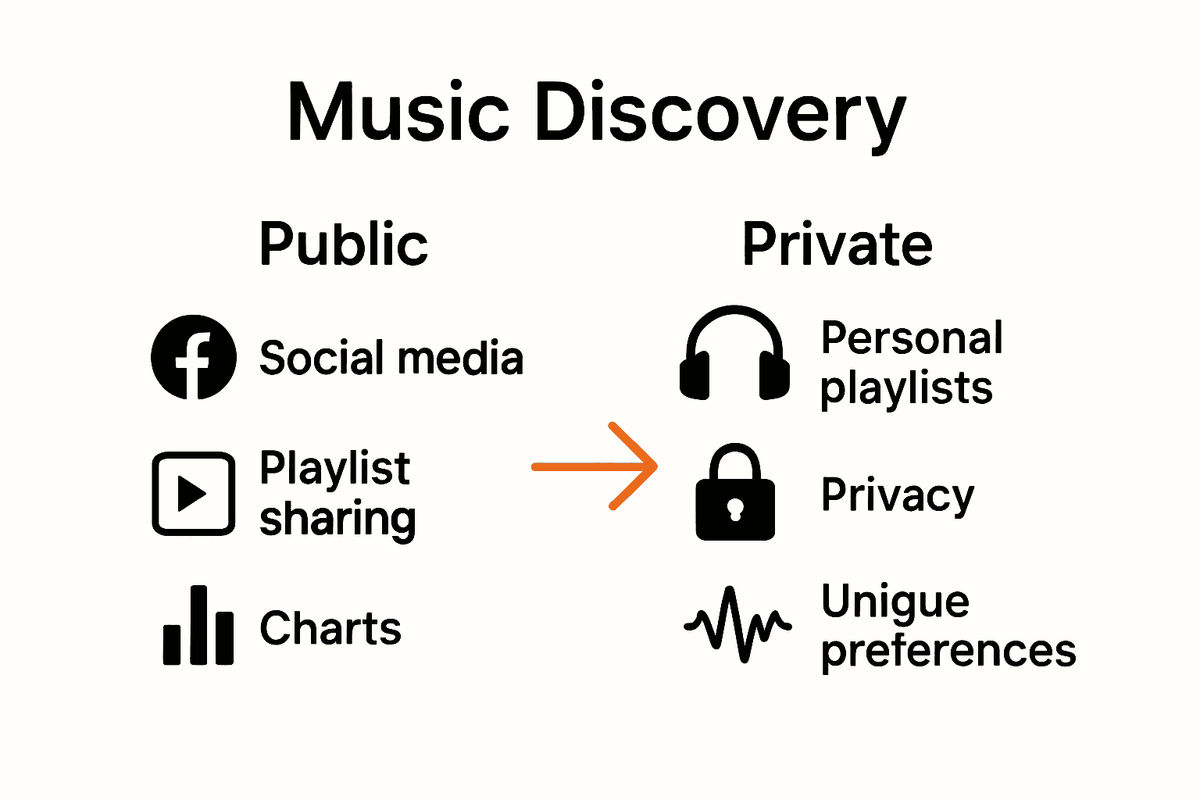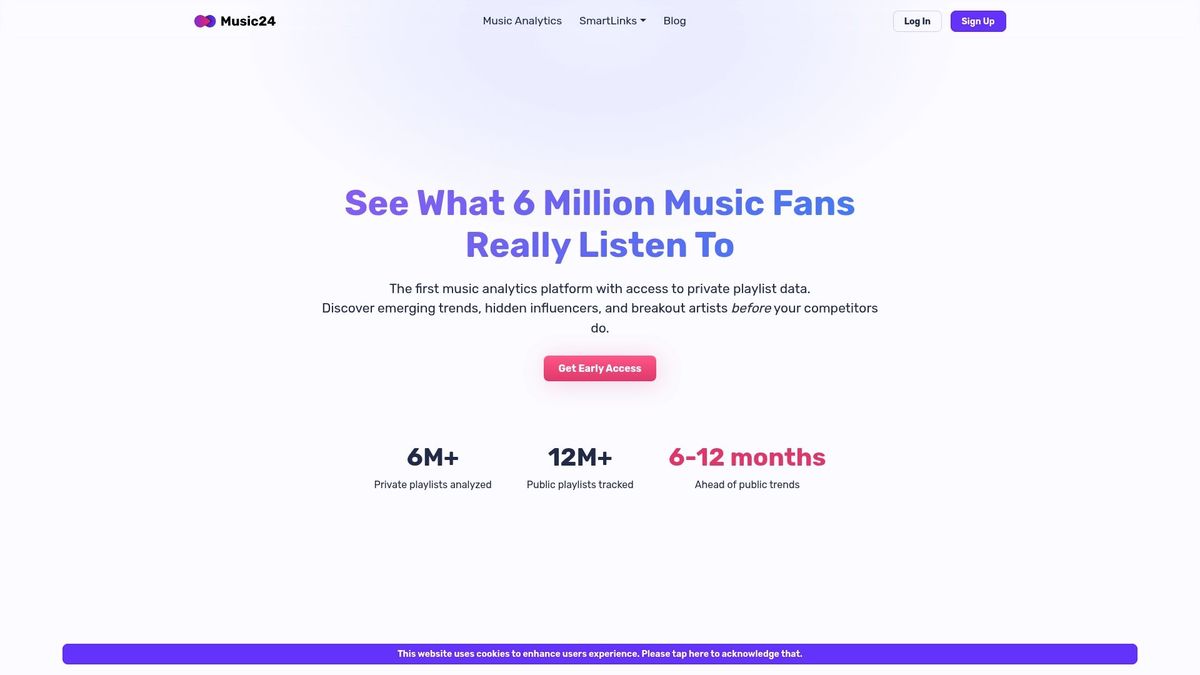Most listeners today rely on more than radio DJs or magazine reviews to discover new music. Social media, streaming platforms, and data-driven recommendations guide these choices. In fact, over 70 percent of music fans explore new sounds through personalized digital platforms and social connections. Understanding how technology and peer influence shape these patterns reveals not just the latest hits, but also offers industry professionals a window into tomorrow’s trends and untapped musical talent.
Table of Contents
- Defining The Modern Music Discovery Process
- Types Of Music Discovery: Public Vs. Private Data
- How Private Playlist Analytics Transform Insights
- Identifying Influencers And Genre Micro-Trends
- Risks, Limitations, And Best Practices In Discovery
Key Takeaways
| Point | Details |
|---|---|
| Evolution of Music Discovery | The music discovery process has shifted from traditional methods to a data-driven model influenced by social interactions and algorithms. |
| Public vs. Private Data | Understanding the distinction between public and private data sources is crucial for identifying listener behaviors and forecasting trends. |
| Harnessing Private Analytics | Leveraging private playlist analytics offers deeper insights into listener preferences, unlocking potential trends before they reach mainstream recognition. |
| Ethical Considerations | It’s essential for industry professionals to balance data insights with user privacy, ensuring ethical practices in music discovery analytics. |
Defining the Modern Music Discovery Process
The modern music discovery process has dramatically evolved from traditional recommendation models into a complex, data-driven ecosystem driven by social interactions and algorithmic intelligence. Research from arXiv highlights how peer networks significantly shape individual music exploration behaviors, transforming how artists emerge and listeners engage with new sounds.
At its core, contemporary music discovery is a multi-layered interaction between technological platforms, social recommendations, and individual preferences. According to research exploring music discovery dynamics, repeated exposure to new songs critically influences user engagement and interest levels arXiv. This means that discovery is no longer a linear process but a dynamic, interactive journey where listeners are active participants rather than passive consumers.
Key characteristics of the modern music discovery process include:
- Algorithmic personalization based on listening history
- Social network recommendations
- Cross-genre exploration facilitated by streaming platforms
- Machine learning-powered predictive suggestions
- Real-time trend tracking
Professionals in the music industry must recognize that discovery now happens through multiple interconnected channels. From private playlist analysis to social media influence, the pathways are complex and constantly shifting. Understanding types of music discovery trends becomes crucial for identifying emerging artists and predicting potential breakout moments before they become mainstream.
The technological landscape has transformed music discovery from a serendipitous experience into a strategic, data-informed process. By leveraging advanced analytics and understanding listener behavior patterns, industry professionals can now anticipate trends, curate experiences, and connect audiences with emerging talent more effectively than ever before.
Types of Music Discovery: Public vs. Private Data
Music discovery data can be fundamentally categorized into two critical domains: public and private data sources, each offering unique insights into listener behavior and emerging trends. Research from Francis Press highlights how both data types are strategically utilized by music industry professionals to identify and predict musical trends.
Public data encompasses information readily accessible through streaming platforms, social media interactions, and publicly shared playlists. These sources provide broad, visible indicators of musical preferences. Conversely, private data represents more nuanced, personalized listening behaviors typically hidden from public view. Interestingly, Unipd Thesis reveals potential privacy risks associated with sharing music preferences, underscoring the sensitive nature of personal listening data.
Key differences between public and private music discovery data include:
- Public Data
- Visible playlist sharing
- Social media interactions
- Public streaming platform charts
- Private Data
- Personal playlist collections
- Non-shared listening history
- Intimate user preferences
For music industry professionals seeking deeper insights, understanding the intricate dynamics of private playlist data becomes paramount. Private data often reveals more authentic listener behaviors, providing unprecedented access to emerging trends before they manifest in public metrics.

The strategic integration of both public and private data sources enables a comprehensive understanding of music discovery ecosystems. By analyzing these multifaceted data streams, industry experts can develop more sophisticated strategies for artist development, audience engagement, and trend prediction.

How Private Playlist Analytics Transform Insights
Private playlist analytics represent a revolutionary approach to understanding music consumption patterns, offering unprecedented depth beyond traditional public metrics. Research from Francis Press reveals how these analytics can transform business strategies by uncovering nuanced listener behaviors that remain invisible through conventional data sources.
The transformative power of private playlist analytics lies in its ability to decode complex listener preferences. According to Unipd Thesis, these analytics can reveal significant correlations between music preferences and personal attributes, providing industry professionals with rich, multidimensional insights that go far beyond surface-level engagement metrics.
Key transformative capabilities of private playlist analytics include:
- Identifying micro-genre trends before mainstream recognition
- Detecting listener mood and contextual music consumption patterns
- Predicting potential breakout artists with higher accuracy
- Understanding cross-genre listener migration
- Mapping intricate listener segmentation
For music industry professionals seeking granular insights, how to leverage private playlist data becomes a critical skill. These analytics provide a window into authentic listener behaviors, revealing trends and preferences that traditional public metrics often miss.
The strategic implementation of private playlist analytics represents more than just data collection—it's about understanding the intricate ecosystem of music consumption. By decoding the complex relationships between listeners, genres, and emerging artists, industry professionals can develop more targeted, personalized strategies that resonate with evolving musical landscapes.
Identifying Influencers and Genre Micro-Trends
Identifying music influencers and genre micro-trends has become increasingly sophisticated, driven by complex social interaction patterns. Research from arXiv reveals how peer networks fundamentally shape individual music exploration behaviors, creating intricate pathways of musical discovery that extend far beyond traditional recommendation systems.
The dynamics of music discovery are deeply rooted in repeated exposure and social influence. According to arXiv, user engagement dramatically increases with repeated interactions with new musical content, highlighting the critical role of sustained exposure in trend formation. This phenomenon underscores the importance of understanding how micro-trends emerge and propagate through interconnected listener networks.
Key strategies for identifying influencers and genre micro-trends include:
- Analyzing private playlist cross-pollination
- Tracking early adoption patterns
- Monitoring niche community interactions
- Mapping genre boundary transitions
- Identifying emerging curator networks
Professional music strategists can gain significant advantages by mapping music micro-trends before they become mainstream. These insights provide a critical early warning system for emerging musical movements, allowing industry professionals to anticipate and capitalize on nascent trends.
The art of trend identification goes beyond simple data collection. It requires a nuanced understanding of listener behavior, social dynamics, and the complex ecosystem of musical exploration. By leveraging advanced analytics and deep social network insights, music industry professionals can transform raw data into predictive intelligence that drives strategic decision-making.
Risks, Limitations, and Best Practices in Discovery
Music discovery analytics present a complex landscape of opportunities and potential ethical challenges, particularly surrounding data privacy and user information protection. Research from Unipd Thesis reveals significant privacy risks associated with sharing music preferences, demonstrating how seemingly innocuous playlist data can be used to infer deeply personal information about listeners.
The strategic utilization of music discovery data requires a nuanced approach that balances analytical insights with ethical considerations. According to Francis Press, while big data analysis offers unprecedented opportunities for understanding music consumption patterns, it simultaneously introduces complex challenges related to data interpretation and user privacy.
Key risks and limitations in music discovery analytics include:
- Potential unauthorized personal data inference
- Risk of algorithmic bias
- Overreliance on quantitative metrics
- Potential privacy breaches
- Complex consent and data usage challenges
Professional music strategists can mitigate these risks by understanding playlist analytics strategy that prioritizes ethical data collection and interpretation. This approach ensures robust insights while maintaining rigorous standards of user privacy and data protection.
Navigating the intricate landscape of music discovery requires a holistic approach that transcends raw data collection. By developing comprehensive frameworks that balance technological innovation with ethical considerations, industry professionals can unlock powerful insights while maintaining the highest standards of user trust and data integrity.
Unlock the Future of Music Discovery with Data-Driven Insights
Navigating the ever-evolving landscape of music discovery is a major challenge for industry professionals who want to stay ahead of emerging trends and influencers. This article reveals the complexity of modern music discovery—from private playlist data to social influences—and highlights the need for a strategic, ethical, and insightful approach to unlock authentic listener behaviors. If your goal is to predict breakout artists and understand nuanced genre micro-trends before they reach mainstream visibility, relying solely on public data is not enough.

Take control of your music discovery process by partnering with a platform designed specifically to analyze millions of anonymized private playlists. With Music24.com, you gain access to predictive analytics that uncover hidden patterns, help you map micro-trends early, and identify influential curators with unmatched accuracy. Don't wait until trends become obvious to everyone else. Start leveraging the power of private playlist analytics today to transform your artist development, marketing strategies, and A&R decisions. Visit Music24.com to get started and experience how deep, authentic data can redefine your approach to music discovery.
Frequently Asked Questions
What is the modern music discovery process?
The modern music discovery process involves a dynamic and interactive journey shaped by algorithmic personalization, social recommendations, and individual preferences, enabling listeners to explore new artists and genres more effectively.
How do public and private data sources differ in music discovery?
Public data consists of visible metrics like shared playlists and social media interactions, while private data encompasses personal listening histories and intimate user preferences, providing deeper insights into listener behaviors.
What role do private playlist analytics play in the music industry?
Private playlist analytics help uncover nuanced listener behaviors, identify emerging trends, and predict breakout artists by providing a deeper understanding of personal music consumption patterns beyond traditional public metrics.
How can music professionals identify influencers and micro-trends?
Music professionals can identify influencers and genre micro-trends by analyzing private playlist data, tracking early adoption patterns, and monitoring niche community interactions to anticipate new musical movements before they go mainstream.


